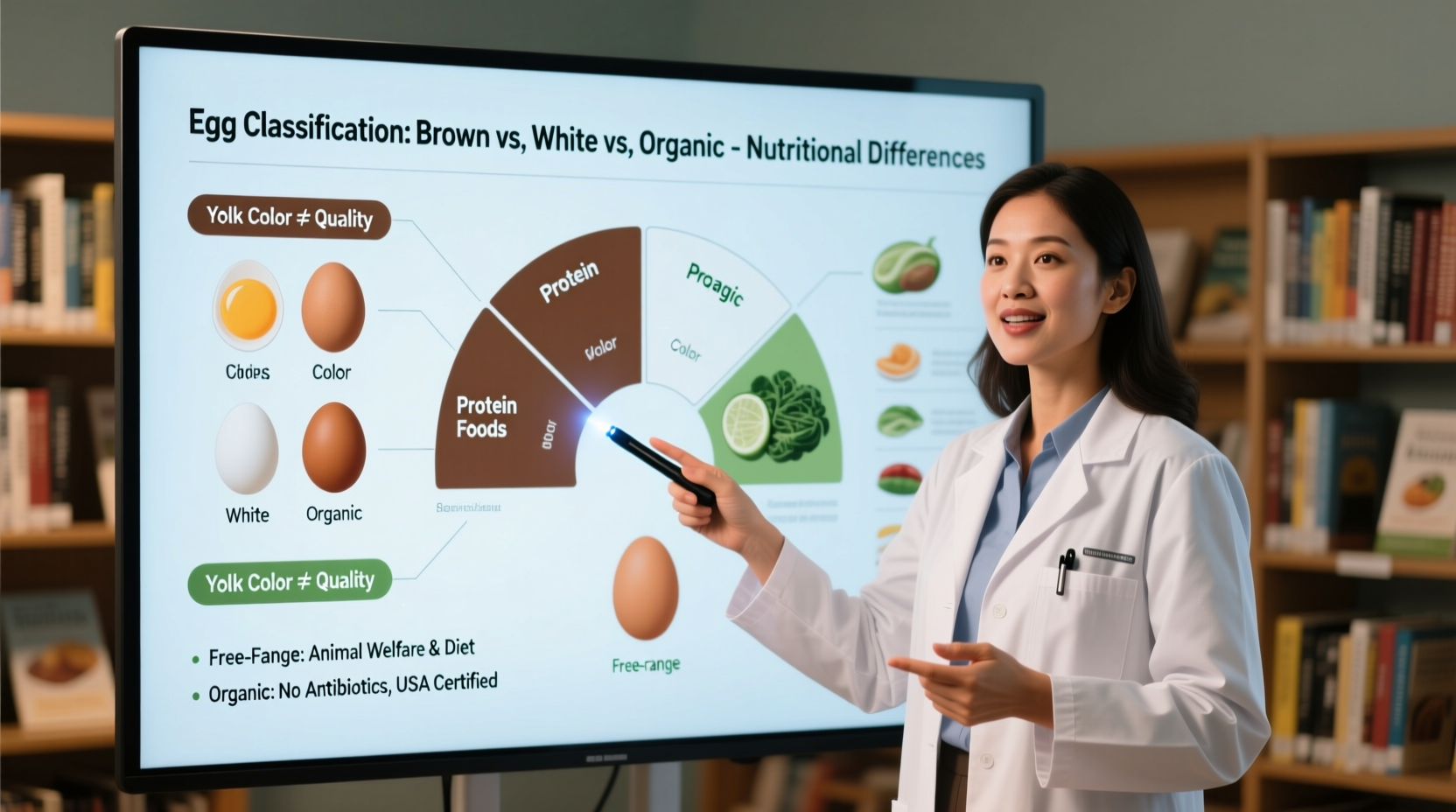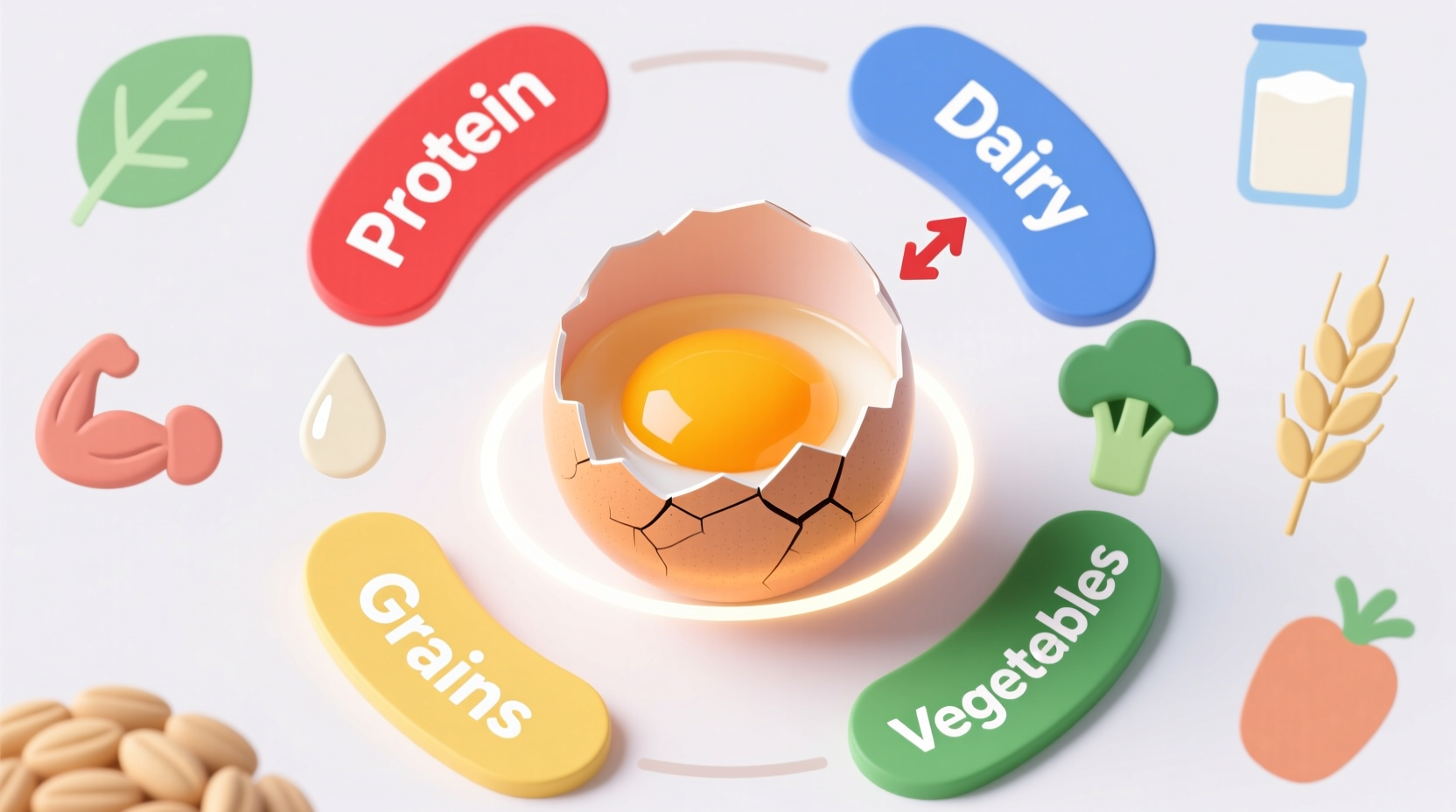Understanding where eggs fit in your daily nutrition plan isn't just academic—it directly impacts how you build balanced meals. Whether you're meal prepping for weight management, fueling athletic performance, or managing dietary restrictions, knowing eggs' proper food group classification helps you make smarter choices at every meal.
Why Eggs Belong in the Protein Group (Not Dairy)
Despite frequent confusion, eggs have never been classified as dairy products. The USDA's MyPlate guidelines explicitly place eggs in the Protein Foods Group alongside meats, poultry, seafood, beans, and nuts. This distinction matters because:
- Dairy products come from mammal milk (cows, goats), while eggs are produced by birds
- Eggs contain virtually no lactose, making them safe for most lactose-intolerant individuals
- Nutritionally, eggs align with protein sources through their amino acid profile and fat composition
The misconception likely stems from grocery store layouts where eggs sit near dairy sections, but this is purely for retail convenience—not nutritional science.
Egg Nutrition Breakdown: What Makes Them a Protein Powerhouse
One large egg (50g) contains:
| Nutrient | Amount per Egg | Daily Value % |
|---|---|---|
| Protein | 6g | 12% |
| Choline | 147mg | 27% |
| Vitamin D | 44IU | 7% |
| Selenium | 15.4mcg | 28% |
Unlike plant-based proteins, eggs contain all nine essential amino acids in optimal ratios, making them a “complete protein.” This biological value (BV) of 100 sets the standard against which other protein sources are measured, according to research from Harvard T.H. Chan School of Public Health.

How Dietary Guidelines Classify Eggs Worldwide
While the USDA places eggs firmly in the protein category, global guidelines show interesting variations worth noting:
| Country/Organization | Food Group Classification | Key Recommendation |
|---|---|---|
| United States (USDA) | Protein Foods Group | 1-2 eggs daily within healthy eating patterns |
| Canada (Food Guide) | Protein Foods | No specific limit; focus on variety |
| United Kingdom (NHS) | Protein group | No daily limit for healthy adults |
| Australia | Lean meats & alternatives | Up to 6 eggs weekly as protein source |
These differences highlight how cultural eating patterns influence dietary guidance while maintaining the core classification of eggs as protein sources. The Dietary Guidelines for Americans specifically note that eggs contribute important nutrients often underconsumed in American diets, particularly choline which supports fetal brain development during pregnancy.
Practical Meal Planning: Incorporating Eggs Properly
Knowing eggs' classification transforms how you build meals. Here's how to apply this knowledge:
- For balanced breakfasts: Pair eggs (protein) with whole grains (toast) and fruits—not additional dairy like cheese
- Vegetarian protein strategy: Combine eggs with legumes for complete amino acid profiles without meat
- Dietary restriction navigation: Eggs provide dairy-free protein for lactose-intolerant individuals
- Portion guidance: Two eggs count as 2 ounce-equivalents in the Protein Foods Group
The American Heart Association confirms that for most healthy adults, consuming up to one whole egg daily fits within heart-healthy dietary patterns. This recommendation considers both the protein benefits and cholesterol content, emphasizing that dietary cholesterol affects people differently.
Evolving Understanding: How Egg Classification Changed Over Time
Eggs' nutritional perception has shifted dramatically through history:
| Era | Nutritional Understanding | Dietary Recommendations |
|---|---|---|
| 1950s-1970s | Focus on cholesterol concerns | Limited to 3 eggs weekly due to heart disease fears |
| 1980s-1990s | Recognition of protein quality | Increased acceptance as affordable protein source |
| 2000s | Understanding of dietary vs. blood cholesterol | Removal of specific cholesterol limits in guidelines |
| 2020s | Focus on nutrient density and bioavailability | Emphasis on eggs' role in addressing nutrient gaps |
This evolution reflects improved scientific understanding of how whole foods function in human nutrition—moving beyond single-nutrient fixation to consider overall dietary patterns. Current research from the National Institutes of Health shows that for 70% of people, dietary cholesterol from eggs has minimal impact on blood cholesterol levels.
Special Considerations for Egg Classification
While eggs consistently fall under protein foods, certain contexts create important nuances:
- Medical diets: Kidney disease patients may need to count eggs in both protein and phosphorus allowances
- Cultural interpretations: Some Asian dietary systems classify eggs as neutral or cooling foods with different balancing principles
- Processing differences: Liquid egg products may have added ingredients affecting classification
- Allergy considerations: Egg allergies require different substitution strategies than dairy allergies
Registered dietitians emphasize that eggs' classification remains consistent across healthy populations, but individual health conditions may require modified approaches to protein intake. The key is understanding eggs' fundamental nutritional profile to make informed adjustments when necessary.
Your Egg Questions Answered
Are eggs considered dairy products?
No, eggs are not dairy products. Dairy comes from mammal milk (cows, goats), while eggs are produced by birds. The USDA classifies eggs in the Protein Foods Group, separate from the Dairy Group. This distinction is important for those with lactose intolerance or dairy allergies, as eggs typically don't trigger these reactions.
How many eggs can I eat per day on a healthy diet?
For most healthy adults, consuming 1-2 eggs daily fits within recommended dietary patterns. The Dietary Guidelines for Americans no longer set specific cholesterol limits, recognizing that for 70% of people, dietary cholesterol from eggs has minimal impact on blood cholesterol. Those with diabetes or heart disease should consult their healthcare provider for personalized recommendations.
Why do some people think eggs are in the dairy group?
This common misconception likely comes from grocery store layouts where eggs are displayed near dairy sections for shopping convenience. Additionally, both categories require refrigeration and contain animal products, creating false association. Nutritionally and biologically, eggs and dairy products come from different sources (birds vs. mammals) and have distinct nutritional profiles.
Do eggs count as protein for vegetarians?
Yes, eggs are a primary protein source for ovo-vegetarians. One large egg provides 6 grams of complete protein containing all nine essential amino acids. For vegetarians avoiding dairy, eggs serve as a crucial protein alternative that's more nutritionally complete than many plant proteins. Two eggs count as 2 ounce-equivalents in the Protein Foods Group.
How do eggs fit into the USDA MyPlate meal planning system?
In the USDA MyPlate system, eggs belong exclusively to the Protein Foods Group. A standard serving is 1-2 eggs, which counts as 1-2 ounce-equivalents. For balanced meals, pair eggs with vegetables (½ plate), whole grains (¼ plate), and optionally fruits. Eggs don't contribute to the Dairy Group portion, so separate dairy servings are needed if including milk or yogurt in your meal plan.











 浙公网安备
33010002000092号
浙公网安备
33010002000092号 浙B2-20120091-4
浙B2-20120091-4